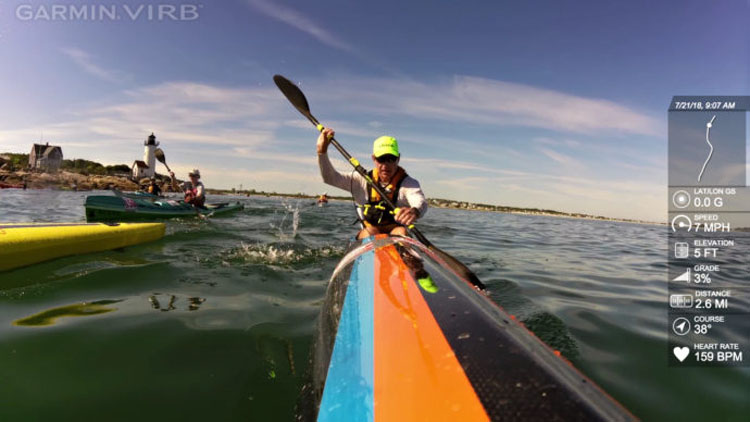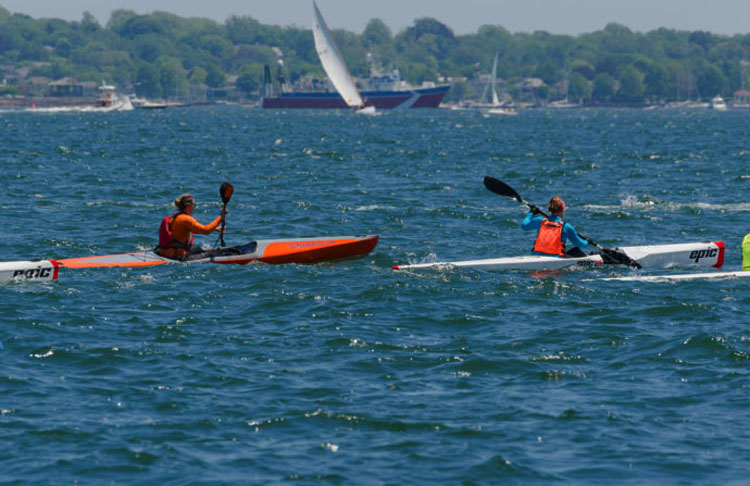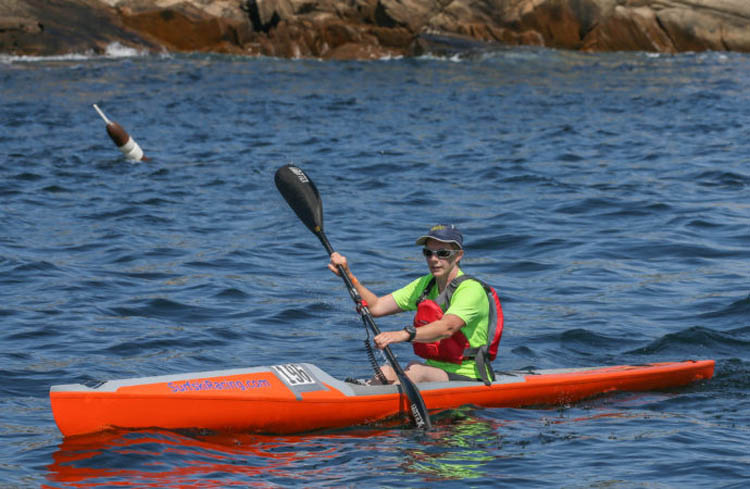|
|
My First Blackburn in a Ski
By Melissa Meyer.
|
|
|
Another Blackburn is in the books. It's such a fun race and supportive community, I'm always excited to sign up. Then, come the 2/3 or 3/4 mark, I'm even more excited to be done with it.
I came in "first place," which honestly is not much of a feat considering I was the only person in my boat class (female HPK. There were a few other gals in tandems and SS20s). I knew going in that this race would be against the men and the clock. I held off a few of the men, and the clock ticked by 3 hours and 23 minutes; not too bad. They had hats for the class winners this year, which as my friend pointed out are quite a bit more wearable in polite society than medals.
2019 was my first Blackburn in a surfski; I've raced it a couple times previously in sea kayaks. And now I'm borderline obsessed with surfski racing. How has it come to this?
|
|

"Photo clip of Melissa to the left, at 2018 Blackburn as I draft Chris Chappell and we overtake Melissa." Photo by Wesley Echols
|
|
|
I contacted Wesley last year after the Blackburn to ask for a lesson on how to use wing paddles, and he wrote back with a still from his race video and said "Is that you?" Yup. He and Chris C. had chugged by me in the middle of the race and we all remembered the encounter, mostly because we all said things to each other but none of us heard what any of the others said. (I thought I remembered Chris advising this dude I had stuck on my tail how to better draft me; I said something like "Hey! I'm trying to win a race here!"). So I set up a lesson with Wesley and walked away that day with a Jantex wing. A few weeks later, I was buying his Stellar SR and changing my Lighthouse to Lighthouse registration from "sea kayak" to "surfski."
|
|

Melissa paddling the 2018 Blackburn Challenge in her Rockpool Taran. Photo courtesy of Wesley Echols.
|
|
|
So I enjoyed the tail end of the 2018 racing season, and looked forward to giving this new toy, which looks and behaves a lot like a kayak, but makes rather different demands of its paddler, a proper shakedown in 2019.
Truth be told, I had toyed with the idea of getting a surfski for a few years already. I raced last year's Blackburn in a Rockpool Taran, which my bae and I got for downwind fun and long cranks. We considered them a "surfski crossover" boat (they're 18 feet long, 20.5 inches wide, and have rudders).
I quickly realized that I had gone from a big fish in a little pond (the vast majority of sea kayakers don't care much about speed) to a big pond full of big fish. Surfskiers are -into- racing; it's what they do.
I've been in six races (has it really only been that few?) since I got my SR, and still, my dominant hope, as I launch myself onto the water, is "please don't let me embarrass myself." The sheer cognitive load was enough to slow me down in the first couple races: concentrating on posture, rotation, catch, the wing stroke, my heart rate, which muscles I was using when, controlling the rudder rather than (my ingrained habit of) edging, not to mention watching the water for rocks, current seams, waves to ride, competitors to draft (or shake), and which darned buoy we are supposed to turn on. I decided that something had to give, and chose to mostly ignore drafting opportunities; I've made some half-hearted attempts since, but that remains an unexplored frontier.
And there are all the little race hacks: How much water should you bring? Where do you carry it? That could modify the trim of the boat, which changes its performance, especially in wind. Do you pin your hydration tube to your PFD? Do you even wear a PFD? And for the longer races, where you might actually need to eat something to keep pushing: maybe tape gel packs to the hull like I saw Dana do at the Blackburn? I put bite-sized pieces of energy bar in my PFD pocket (already unwrapped is key!).
So I am learning a lot about racing. When I say that this year's Blackburn was a weird race for me, I guess that just means I don't know enough about my typical performance to explain what happened.
In every other race, I've been limited by my aerobic capacity. (Well: my speed in that upwind groaner at the end of Ride The Bull was strength-limited.) But my heartrate for most of the Blackburn was far slower than my normal racing rate. I knew I wanted to push harder, but different parts of my legs and feet kept threatening to cramp up. I simply couldn't push as hard as I normally do. Why? I was careful with nutrition, hydration, and electrolytes leading up to the race. Was it the heat? The humidity?
|
|

Fighting the headwinds of Ride The Bull. Photo by Olga.
|
|
|
It all started quite well. I left the starting line strong and was able to hang on to the back of the main pack of men for most of the Annisquam. (Close enough to draft! Maybe I'll sidle over toward him. Nah, he moved away. Maybe this other dude? Ack, this wake is pushing me around. Screw that. Note to self: learn to draft later.)
As the ocean opened up in front of me at Annisquam Light, just 30 or 40 minutes into my race, I noticed my heartrate dropping, but for whatever reason could not work any harder. The main pack of men moved off into the distance and it became, as far as I was concerned, a solo race against the clock. My cadence drooped too, and the music I had playing in my head (Oasis - What's The Story, Morning Glory) slowed down until it didn't make sense anymore, at which point the record started skipping and I think I listened to the same five or six bars of that song for a long time until I passed by a sea kayaker I know and he broke me out of it.
I kept trying to rally, but each time a new body part would feel crampy and I would have to back off. It was incredibly frustrating, because I didn't even feel like I was working hard (even though, in the only sense that mattered, I was working as hard as I was able). I knew if my leg cramped up, that would almost certainly mean a capsize. It occurred to me later that, had I actually capsized, it probably would have helped my overall time. If heat was my problem, then dorking around in the water for a minute or two trying to rub out a cramp and remount would have cooled me down nicely. Ah, well. Next time!

Straitsmouth, mile 10. I was fighting off a foot cramp and hoping I didn't have a weird look on my face when this photo was taken. Photo courtesy of Wesley Echols
Speaking of capsizing, I was also surprised by the number of boat wakes which, running every which way at once, made for a pretty technical paddle in places. Expecting hot and flat from the forecast, I had swapped in my four-inch rudder (oh, yeah - at the finish line I found that my "weedless rudder" was dragging weeds between it and the hull. Another race hack I need to learn?) and I wished for the more assertive steering of my eight-inch rudder at times. Occasionally when I'm paddling, I'll see a big wake coming and preemptively throw a brace, and then I know I must be getting tired and it's wearing on my psych. At those times, I'll often speak to myself out loud: you got this babe, just punch through it. I am in complete control of this boat.
I nursed myself along until I made it to the breakwater, and then in the harbor for the final two miles I was able to push hard again (though still nowhere near my usual race heartrate). Must have been excitement for the beer, or more likely, the energy bar bites I ate somewhere around the halfway point were starting to kick in. I had been hearing one of the OC-6s behind me for the last three or four miles (hup! hoooou), and I managed to stay out in front of them to the finish. Yeah! Different boat class, and their heat started after mine, but they provided the little bit of competition I wanted there at the end.

At the finish. Photo by Leslie Chappell.
So that was my first Blackburn in a surfski. I'll be back next year. Now that I've got a surfski, will I ever paddle a sea kayak again? You bet; IMO there's nothing more seaworthy than an NDK, for playing in rocks and tideraces, leading and protecting groups on exposed trips, and of course camping. In cold water, I still think the ability to roll is very important.
But for racing? And downwind summer day trips? I'm a convert. The great benefit of paddling a surfski instead of a sea kayak is that I have got a tan on my legs, for perhaps the first time in my adult life.
Just kidding. It's the joy of using the right tool for the job. Want to go fast? Surfskis are ergonomically set up for powerful strokes, leg drive, proper torso rotation, and a tight catch. They're light and long and streamlined. They're no-fuss craft for skimming across the surface of water as fast as possible. They are racing machines.
|
|


|
| | | | |
